Canon has made a significant advancement in the realm of virtual reality (VR) content creation with the unveiling of its latest lens—the RF-S7.8mm F4 STM Dual. This innovative lens is designed to cater to the needs of creative professionals and enthusiasts alike, providing a more accessible entry point into 3D video production without compromising on quality. Launched to coincide with the rising demand for immersive content, particularly for devices such as the Meta Quest 3 and Apple Vision Pro, this lens redefines what creators can achieve with a compact and affordable option.
Cost-Effective Alternatives for Creators
Traditionally, creating high-quality 3D content required substantial investment in specialized equipment. Canon’s strategy with the RF-S7.8mm lens is refreshingly democratizing; priced at approximately $449.99, it offers a viable alternative to the considerably more expensive dual-fisheye lenses that can exceed $1,900. This pricing strategy reflects a growing understanding within Canon of the unique challenges faced by content creators who want high-quality 3D output without the hefty price tag.
When combined with the Canon EOS R7, which has a starting price of $1,299, the total investment of over $1,700 remains more budget-friendly compared to Canon’s premium 3D solutions that begin at $2,498. For budding content creators, this represents a valuable opportunity to experiment with stereoscopic video without entering the realm of astronomical costs typically associated with professional equipment.
The RF-S7.8mm F4 STM Dual isn’t just a cost-cutting initiative; it comes packed with impressive features that cater to the creative aspirations of users. With an aperture range from f/4.0 to f/16, it provides versatility in various lighting conditions while supporting autofocus to ensure sharp imagery. One notable addition is the inclusion of manual focus adjustments for each side of the lens, allowing creators to fine-tune their shots for optimum 3D effects.
However, this entry-level lens does come with limitations. Its field of view is significantly narrower compared to Canon’s other high-end offerings, capturing only 63 degrees as opposed to the full 180 degrees provided by more expensive models. This could be a point of contention for some creators aiming for the most immersive experiences possible, yet it also positions the RF-S7.8mm as an ideal tool for specific, close-up shots, making it particularly useful for tabletop product showcases or intimate VR experiences.
The design of the new lens traces a straight optical path, with its front lenses positioned just 11.8 mm apart. This is a stark contrast to the broader spacing found in Canon’s premium lenses, resulting in a texture and depth perception that should work best within a specific range of distances—between 6 to 20 inches from the subject. This limited grasp does mean that distant subjects will yield a weaker 3D effect, which could frustrate those hoping to capture expansive landscapes or larger scenes in impressive stereo detail.
Furthermore, the output of images and videos through the RF-S7.8mm lens requires post-processing before they can be enjoyed on VR or Augmented Reality (AR) headsets. By utilizing the EOS VR plugin available for Adobe Premiere Pro or Canon’s own EOS VR Utility software, users can generate compelling spatial content—albeit with a paid subscription model for software access.
Canon’s introduction of the RF-S7.8mm F4 STM Dual lens marks a noteworthy shift in the accessibility of 3D video content creation. While it incorporates some limitations in its field of view and necessitates subsequent processing, the lens expertly balances quality and affordability. It enables a wide array of creators—from hobbyists to more seasoned professionals—to explore the exciting world of stereoscopic video with reduced financial barriers. As immersive technologies continue to evolve, Canon’s latest offering represents a meaningful step toward inclusivity in the ever-expanding digital storytelling landscape.


Leave a Reply